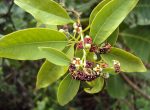 Also called Indian sandalwood, this semi-parsitic deciduous tree is native to southern India and Southeast Asia where it grows mostly in dry deciduous and scrub forests but can also be found in wet forests and beach areas. It is a member of the Santalaceae, a widely distributed family that also includes mistletoe. Plants attach by haustoria to the roots of other trees that provide light shade as well as micronutrients nitrogen, phosphorus, and potassium. Growing 13-66′ tall, the trees have reddish-brown, dark brown, dark gray to black bark that is smooth when young but develops vertical cracks with age. The slender dropping branches carry thin, opposite leaves that are ovate to lanceolate and 1-8″ long. The leaves are bright green, shiny above, pale yellow green below, and have rounded or pointed tips and conspicuous reticulate veining. The small purplish-brown flowers with 5 tepals appear in terminal or axillary clusters in from March to April in its native habitat in India. The fruit is a small blackish-purple beaked drupe with one seed. White sandalwood has been highly valued for its sweet fragrance and use as a medicine, perfume and incense in the East for at least 4,000 years. It also been used for fine carving and cabinet work, as a food flavoring, and as an ornamental. The trees are very long lived but harvest is possible only after many years. The genus name, Santalum, is from the Greek santalon meaning sandalwood. The specific epithet, alba, is the Latin word for white and refers to the bark.
Also called Indian sandalwood, this semi-parsitic deciduous tree is native to southern India and Southeast Asia where it grows mostly in dry deciduous and scrub forests but can also be found in wet forests and beach areas. It is a member of the Santalaceae, a widely distributed family that also includes mistletoe. Plants attach by haustoria to the roots of other trees that provide light shade as well as micronutrients nitrogen, phosphorus, and potassium. Growing 13-66′ tall, the trees have reddish-brown, dark brown, dark gray to black bark that is smooth when young but develops vertical cracks with age. The slender dropping branches carry thin, opposite leaves that are ovate to lanceolate and 1-8″ long. The leaves are bright green, shiny above, pale yellow green below, and have rounded or pointed tips and conspicuous reticulate veining. The small purplish-brown flowers with 5 tepals appear in terminal or axillary clusters in from March to April in its native habitat in India. The fruit is a small blackish-purple beaked drupe with one seed. White sandalwood has been highly valued for its sweet fragrance and use as a medicine, perfume and incense in the East for at least 4,000 years. It also been used for fine carving and cabinet work, as a food flavoring, and as an ornamental. The trees are very long lived but harvest is possible only after many years. The genus name, Santalum, is from the Greek santalon meaning sandalwood. The specific epithet, alba, is the Latin word for white and refers to the bark.
Type: Deciduous tree
Outstanding Feature: Fragrant wood and oil
Form: Sprawling or upright
Growth Rate: Slow
Bloom: Terminal or axillary clusters of small purplish-brown flowers with 5 tepals from March to April
Size: 13-66′ H
Light: Full sun but tolerates partial shade
Soil: Fertile, moderately moist, well-drained, slightly acidic but produces the best oil in dry rocky soil.
Hardiness: Zones 10-11
Care: Not available
Pests and Diseases: Not available
Propagation: Seed, branch cuttings and cleft grafting
Outstanding Selections: Not available
Photo Credit: Wikimedia